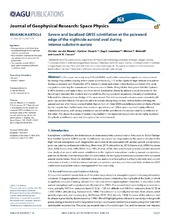Severe and localized GNSS scintillation at the poleward edge of the nightside auroral oval during intense substorm aurora
van der Meeren, Christer; Oksavik, Kjellmar; Lorentzen, Dag Arne; Rietveld, Michael T.; Clausen, Lasse Boy Novock
Peer reviewed, Journal article
Published version

Åpne
Permanent lenke
https://hdl.handle.net/1956/12989Utgivelsesdato
2015-12Metadata
Vis full innførselSamlinger
Originalversjon
https://doi.org/10.1002/2015ja021819Sammendrag
In this paper we study how GPS, GLONASS, and Galileo navigation signals are compromised by strong irregularities causing severe phase scintillation (σϕ>1) in the nightside high-latitude ionosphere during a substorm on 3 November 2013. Substorm onset and a later intensification coincided with polar cap patches entering the auroral oval to become auroral blobs. Using Global Navigation Satellite Systems (GNSS) receivers and optical data, we show severe scintillation driven by intense auroral emissions in the line of sight between the receiver and the satellites. During substorm expansion, the area of scintillation followed the intense poleward edge of the auroral oval. The intense auroral emissions were colocated with polar cap patches (blobs). The patches did not contain strong irregularities, neither before entering the auroral oval nor after the aurora had faded. Signals from all three GNSS constellations were similarly affected by the irregularities. Furthermore, two receivers spaced around 120km apart reported highly different scintillation impacts, with strong scintillation on half of the satellites in one receiver and no scintillation in the other. This shows that areas of severe irregularities in the nightside ionosphere can be highly localized. Amplitude scintillations were low throughout the entire interval.
